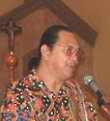Patriots. What a noble term for noble hearts.
Filipino patriots. A rare breed.
Cory Aquino launched a movement called People Power
People. She said she was tired of politics. She said
that too much politics were becoming an obstacle to
progress. And she wanted none of it anymore except to
pray for clean and honest elections. And dedicate her
life to helping people who are dedicated to helping
other people.
Last Aug. 21, Cory Aquino honored her first twenty
People Power People organizations. The auspicious
affair was held in The Tent of The Fort restaurant
complex near the Makati business district. On Oct. 4
and 5, which is this coming Saturday and Sunday, one
of her awardees will honor the thousands of nameless
and faceless volunteers who dedicate their time,
talent and treasure to ease the pain of the poor and
to change the course of Philippine history.
The Gawad Kalinga is a special community development
movement aimed at transforming the lives of the most
disabled among Filipinos, the poorest of the poor, by
first transforming the lives of those who have the
resources. It uses its integrated perspective and
massive approach to set a revolutionary trend of
social reform and capacity building.
Giving priority to bite-sized communities of 100
families or less, the Gawad Kalinga begins with a
volunteer caretaker team whose battle cry is a simple
"Care and Share!" This team establishes
relationships with the poorest of Philippine society,
mostly situated in squatter relocation sites that
have deteriorated into slums. Through those budding
relationships, a carefully studied and heavily
experimented empowerment program is applied.
It is accurate to say that the wholistic Gawad
Kalinga movement addresses all the main concerns of a
community. It has housing, it provides education, it
addresses health concerns, and facilitates technical
training and entrepreneurship. The Gawad Kalinga even
requires its community members to form a homeowners'
association called Kapitbahayan, and uses this
association to be responsible for community
governance.
There are 240 Gawad Kalinga communities today from
just 12 when the year 2002 began. In less than two
years, an estimated 6,000 families have been the
recipients of clean, brightly colored houses that
replaced the shanties they once owned. And because
the Gawad Kalinga is not a mere housing program, 6,000
families and all those who are influenced by the
movement begin a journey towards their elusive
emancipation.
Gawad Kalinga houses are truly attention getters. It
is difficult to look at clusters of brightly painted
houses, beautifully landscaped at that, without being
taken aback by the sight. They emerge like the lotus
in a pool of dirty water and become symbols of
transformation.
For transformation is, indeed, the objective of the
Gawad Kalinga. It is to transform slums to decent
communities, crime-free and productive. That means
changing the slum culture of its victims and not just
the shanties that symbolize poverty.
Just as importantly, the Gawad Kalinga moves to
transform uncaring and uninvolved Filipinos to
volunteer their services or resources in one
magnificent drive to restore the sense of community
and nation. The objective of restructuring social
relationships founded on respect and fraternity is
viewed as the effective and sustainable approach to
reverse the divisiveness of Philippine society.
On the surface, the Gawad Kalinga is a poverty
intervention program. It is, and it is much more. It
seeks to pre-empt the emergence of corruption by
promoting the Kapitbahayan values of Bayanihan [community
collaboration], of countering the pattern of
exploitation of power by instead empowering members
of the community.
The leadership of the Gawad Kalinga movement intends
to expand the influence of Kapitbahayan values by
entering into multi-sector partnerships. These
partnerships bring more individuals and groups to
join volunteer work in building homes, in teaching
and feeding young, pre-schoolers, in dispensing
health services, and in bringing livelihood and
employment opportunities.
The miracle of the Gawad Kalinga is its own existence
in the face of national despondency and hopelessness.
When more and more Filipinos lose hope for that
proverbial but elusive meaningful and sustainable
change, a movement to precisely deliver hope to the
most marginalized and miserable of society is taking
off an taking many areas by storm.
The latest survey results show a dangerous trend in
the mood of the Filipino people. Not only do 55
percent believe that the July 27 military mutineers
had cause to do what they did, but also a hefty 40
percent are not opposed to the idea of martial law or
anything like it. These tabulated results of people's
feelings and thoughts practically serve as an
invitation to the military to take over government.
This massive downturn, though, only serves to make
Gawad Kalinga adherents even more determined to push
the movement to more communities with the help of
local government units and multi-sector partners. To
them, the Gawad Kalinga is the only option left to
change in peace guided by the tenets of faith and
patriotism.
- end of article -

